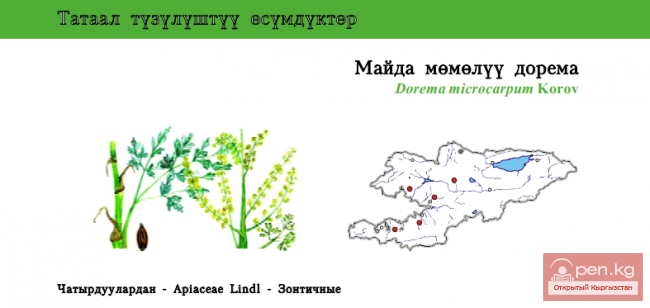
Kashgarian Barberry Status: VU. Rare species....

Knorring’s Haw-tree Status: VU. A narrowly endemic species....

Schrenk’s False Spirea Status: CR B2ab(iii). Endemic, ornamental, and rare plant with a decreasing...

Tien Shan Sibiraea Status: CR. An endemic, decorative, and rare northern Tien Shan plant....

Uzun-Akhmat Grape Status: VU. Endemic species of Western Tien Shan....

Korzhinski’s Pear Status: VU. One of three species growing in the territory of the Kyrgyz...

Alai Bubblewort Status: VU. A rare narrowly endemic species....

Acantholimon compactum Status: VU. A very rare narrowly endemic species....

Olga’s Sorbaria Status: CR B2ab(iii). A rare narrow-endemic species of the Alai Mountain Range....

Lepidolopha Komarovii Status: EN. An endemic species of mountainous Central Asia, representative...

Persian Rowan Status: VU. Endemic, ornamental species....

Catmint-like Scullcup Status: VU. A very rare narrowly endemic species. Ornamental plant....

Iskandera Alai Status: VU. A very rare narrow endemic species. There is only one species of this...

Andrachne-like Scullcup Status: VU. A very rare rocky species, narrowly endemic to a small section...

Vvedensky’s Sage Status: VU. A very rare narrowly endemic species. An ornamental plant....

Niedzvetzki’s Apple-tree Status: VU. Very rare, endemic, endangered species with a small...

Short-winged Bladder-senna Status: VU. One of three very rarely occurring species of this genus in...

Minkwitz’s Bastard Toad-Flax Status: CR. Subendemic. An extremely rare relict plant that is...

Kosopoljanskaya Turkestanian Status: VU. One of the two endemic species of this genus found in...

Sclerotiaria pentaceros Status: CR B2ab(iii). Endemic to a monotypic genus....

Kashgarian Bean Caper Status: VU. Rare, little-studied endemic species....

Schennikov’s Otostegia Status: VU. A rare endemic species, endemic to Kyrgyzstan with a disjunct...

Aulie-Ata Stemmacantha Centaury Status: EN. A very rare species, critically endangered....

Hairy Flowering Plant Aulie-Ata Status: EN. A representative of a monotypic section, a narrowly...

Alai Centaury Status: VU. Endemic species....

Dwarf Ammopiptanth Status: EN. A rare species with a disjunctive range. One of two known...

Seaholly-like Meadow Saxifrage Status: VU. Endemic. One of 16 species found in Kyrgyzstan....

Zenaida’s Tulip Status: VU. A narrowly endemic species of the Kyrgyz Ridge, at risk of rapidly...

Eremurus Zenaidae Status: VU. Endemic to the lower and middle belts of the Fergana and Alai...

Dorema microcarpum Status: VU. Rare endemic species....

Tianschaniella umbellifera Status: VU. A significantly declining narrowly endemic species of...

html Lamyropappus schakaptaricus Status: VU. A rare representative of a monotypic genus....

Quadrifolious Tulip Status: VU. Endemic to the Inner Tien Shan....

Glacial Pastinacopsis Status: EN. A rare endemic species of a monotypic genus in the Northern Tien...

Rhodiola litwinowii Status: LC. A mosaic-distributed species, intensively used in agriculture....

Eremurus zoae Status: VU. A narrowly endemic species of the Kyrgyz Range....

Golden Trichanthemis Centaury Status: VU. A rare narrowly endemic species of the Alai Ridge, an...

Ostrovski’s Tulip Status: VU. A narrowly endemic species of the Kyrgyz and Zailiysky ranges. It...

Pskem Onion Status: EN. A very rare species with a shrinking range in the Western Tien Shan....

Anomalous Alajja (Erianthera anomala) Status: VU. Endemic to the mountains of Central Asia. A rare...

Eugenia’s Bell-flower Status: VU. Endemic to the Western Tien Shan (Talas and Fergana Ranges). A...

Wrapped Alpine Saw-wort Status: VU. Rare species. Found in Kyrgyzstan at the edge of its range....

Land resources refer to lands that are systematically used or suitable for use for economic...